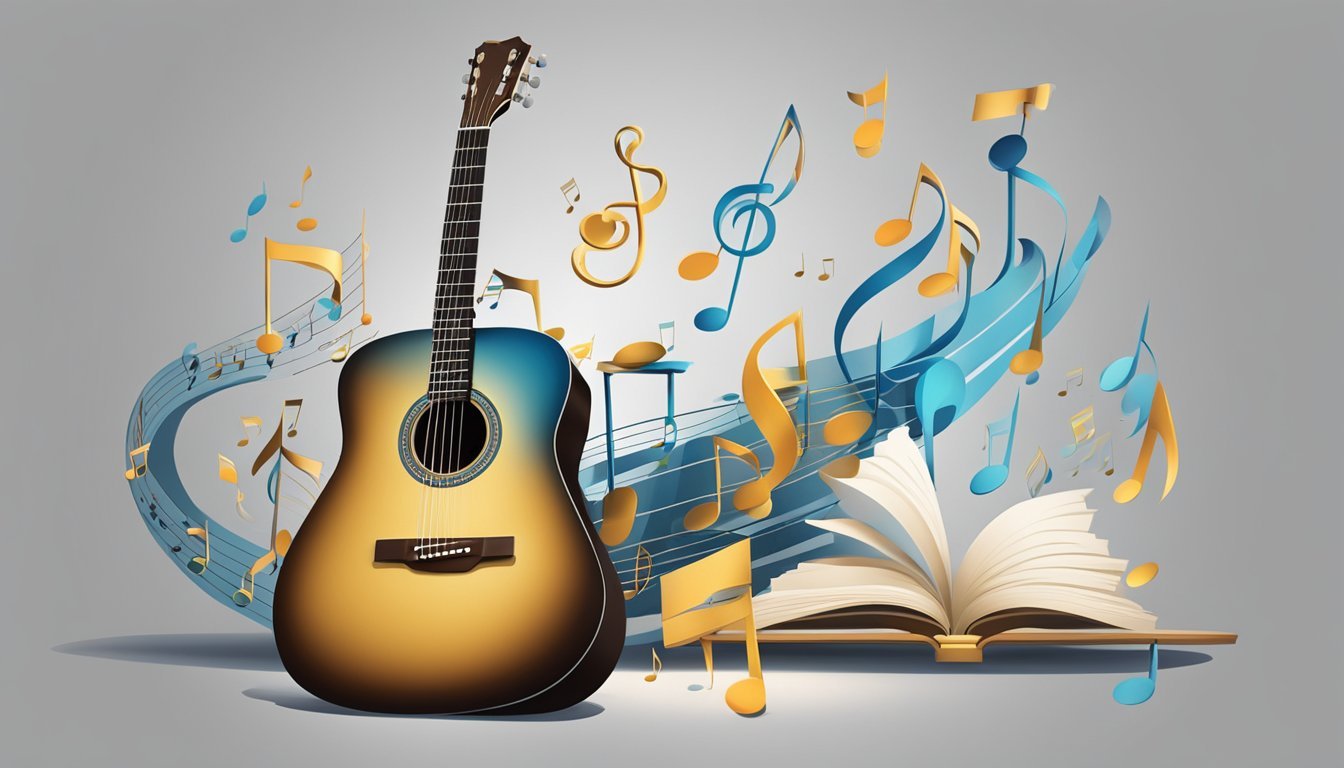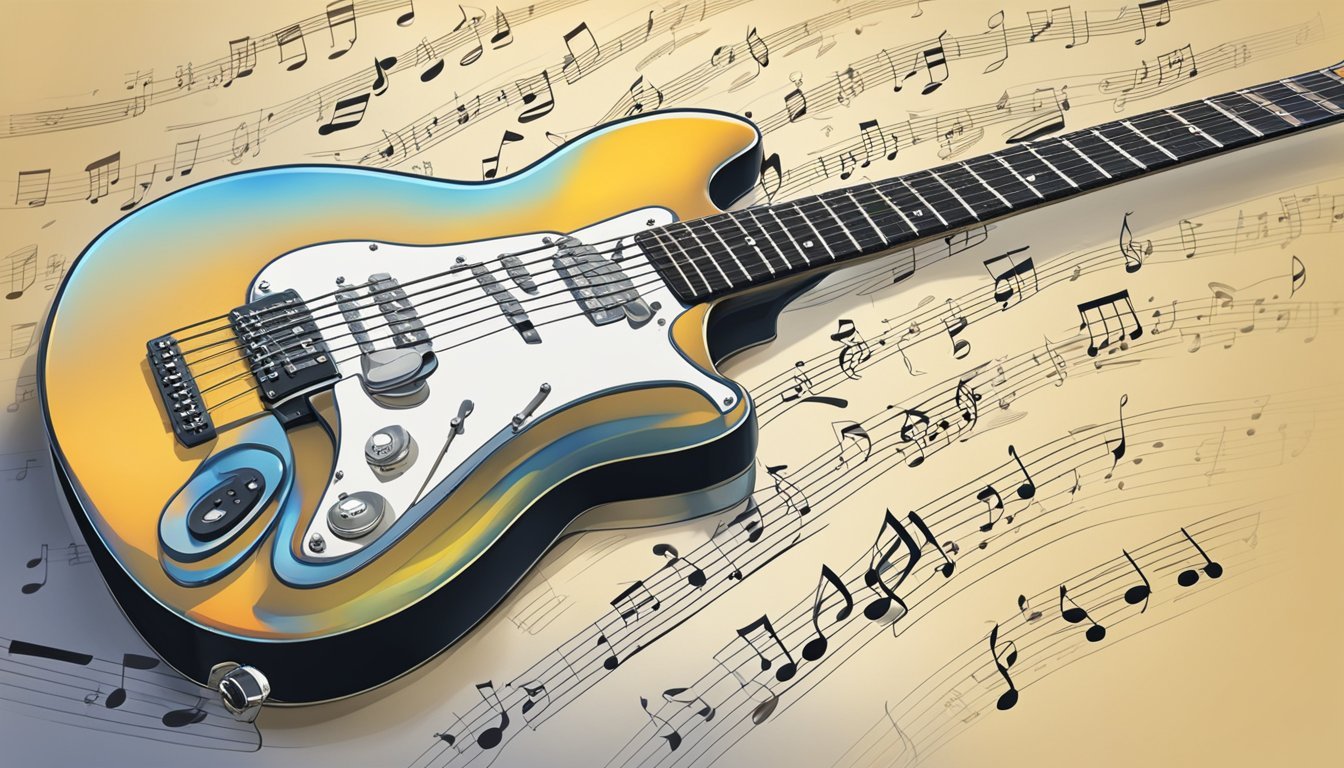Learning to read guitar music can seem tricky at first, but it’s an essential skill for any guitarist. Mastering guitar tabs allows you to play your favorite songs without the need for complicated sheet music. With the right guidance, you can quickly become confident in your ability to understand and use guitar tabs.

Guitar tablature, or tabs, is a straightforward way to show where to place your fingers on the fretboard.
You’ll discover how to follow the numbers and lines on the tab, making it easier to learn chords and melodies.
Once you get the hang of it, you’ll unlock a whole new world of music at your fingertips.
As you practice, it’s helpful to connect what you learn in tabs with basic music theory.
This connection will give you a deeper understanding of how songs are structured, making your practice sessions more rewarding.
With patience and practice, you’ll be playing like a pro in no time!
Key Takeaways
- Guitar tabs are an easy way to learn songs.
- Understanding tabs helps connect music theory with practice.
- Regular practice boosts your confidence and skills.
Fundamentals of Guitar Tabs
When learning to play guitar, understanding tabs is essential.
Tablature provides a visual way to see where to place your fingers.
It simplifies note reading and helps you play songs faster.
Understanding Tablature Notation
Guitar tabs use a system of lines and numbers to show you how to play notes.
The lines represent the strings on your guitar.
The bottom line is the lowest string (E), and the top line is the highest string (e).
Numbers on the lines indicate which fret to press.
For example, a “0” means play the string open, and a “2” means press down on the second fret.
Here’s a quick reference for standard tuning:
- E (1st string)
- B (2nd string)
- G (3rd string)
- D (4th string)
- A (5th string)
- E (6th string)
This layout helps you quickly identify notes and chords to play.
Deciphering String and Fret Numbers
When reading tabs, focus on both string and fret numbers.
Each number shows a specific note you can play.
For chords, you may see multiple numbers stacked vertically on the same vertical line.
It’s crucial to practice recognizing these combinations.
For instance, if you see the numbers “2” and “3” in a chord, you’ll press the second fret on one string and the third fret on another.
The goal is to get your fingers moving smoothly across the fretboard.
Practicing with simple tabs can help you become familiar with the layout, making it easier to play popular songs.
Technicalities in Reading Guitar Tab
When you read guitar tab, it’s essential to understand how chords, techniques, and timing all play a role in making music.
Knowing these details helps you play more accurately and expressively.
Let’s break down these important aspects.
Mastering Chords and Strumming
Chords are the backbone of many songs.
In tab, you’ll see numbers on lines that represent the frets to press on each string.
For example, a simple C chord might look like this:
e|---0---
B|---1---
G|---0---
D|---2---
A|---3---
E|-------
Here, the “0” means you play the open string, while the numbers tell you which fret to press.
Strumming patterns are often shown in tabs as symbols or instructions.
You might come across “D” for a downstroke or “U” for an upstroke.
Practicing consistent strumming helps you keep the rhythm, making it easier to play along with songs.
Playing Techniques and Expressions
Techniques can add flair to your guitar playing.
Some common ones include:
- Hammer-on: You strike a note and then use a finger to press down on a higher fret without picking again.
- Pull-off: This is the opposite of a hammer-on; you pull your finger off a fret to sound a lower note.
- Slide: Move your finger along the string from one fret to another smoothly.
- Bend: Push the string up to change its pitch.
- Vibrato: Slightly wiggle the string to create a smooth, wavy sound.
- Palm muting: Lightly place your palm on the strings near the bridge while strumming for a muted sound.
These techniques often get indicated in the tab.
For example, a bend may be noted with “b” and a pull-off with “p”.
Using these will improve your expressiveness while playing.
Timing and Rhythm Essentials
Timing is crucial in music, and understanding rhythm notation can really help.
In a tab, you’ll often see rhythms notated with numbers and symbols.
Pay attention to beats and time signatures.
A common time signature is 4/4, which means there are four beats in a measure.
Rests will show where you pause.
Strumming patterns can also dictate how you group beats.
For instance, a simple down-up-down-up pattern is often used.
In fingerpicking, you’ll typically pluck strings in a specific order to create a smooth sound.
By incorporating these timing techniques, you’ll stay in sync with the music.
Connecting Guitar Tabs with Music Theory

Understanding how guitar tabs connect with music theory can enhance your playing skills.
This knowledge helps you to read music better and grasp the structure behind the notes you play.
Musical Notation Versus Tablature
Musical notation and tablature serve different purposes. Standard notation uses a staff to show notes, rhythms, and dynamics.
Each note sits on a line or space, with notes like whole notes, half notes, and quarter notes having specific values.
In contrast, guitar tabs display which fret and string to play.
Tabs are simpler but don’t show the rhythm as clearly.
For example, a quarter note in standard notation lasts one beat, while a series of eighth notes take up that same time but are played faster.
Both methods are valuable.
Learning to read music helps you understand timing and note value, while tabs offer quick insights into playing specific songs.
Use sites like Ultimate Guitar for a mix of both.
Understanding Key Signatures and Scales
Key signatures form the backbone of music theory.
They appear at the beginning of a piece and tell you which notes will be sharp or flat.
This helps you know the scale and mood of the music.
When you see a G major key signature, for example, it has one sharp.
In this key, the notes that are sharp are F#.
Knowing this helps you play the correct notes and understand the song’s structure.
Beyond key signatures, scales play a key role in music.
They are sequences of notes that create melodies and harmonies.
Familiarizing yourself with major and minor scales lets you improvise and compose your own music, linking theory back to your guitar practice.
Practical Tips for Practicing Guitar Tabs
Practicing guitar tabs can be fun and rewarding.
Here are some tips to help you get the most out of your practice sessions.
1.
Start Simple
Pick easy songs that you enjoy.
This makes learning more exciting.
Songs with basic chords will help you get comfortable with reading tabs.
2.
Focus on Techniques
Work on one guitar technique at a time.
Techniques like hammer-ons and pull-offs can help improve your skills.
Use tabs that highlight these techniques.
3.
Use Software Consider using tools like Guitar Pro 8.
This software can display tabs in a clear way and even play the music for you.
It helps you understand the rhythm while you practice.
Additionally, many software options come with features that allow you to slow down the tempo, making it easier to master challenging sections.
Whether you’re a beginner or an advanced player, these tools can enhance your learning experience, especially when you’re trying to figure out how to play country roads.
With practice and the right resources, you’ll be able to enjoy playing your favorite songs with confidence.
4.
Listen While You Play
Listening to the song while playing the tabs is key.
It helps you connect the notes on the page with the sounds.
This way, you get better at timing and feel.
5.
Write Your Own Tabs
Try writing your own music.
It can deepen your understanding of how tabs work.
Plus, it’s a creative outlet!
6.
Consistent Practice
Set aside regular time for practice.
Even 15-20 minutes a day can make a big difference.
Staying consistent helps you become a better guitarist over time.
Frequently Asked Questions
Reading guitar tabs can seem tricky at first, but with a little guidance, you can get the hang of it.
Here are common questions to help you understand how to read tabs and chord diagrams effectively.
What’s the easiest way to start reading guitar tabs?
The best way to begin is to practice with simple songs.
Start by looking at the tabs and figuring out which numbers correspond to the frets.
Try playing a few notes to get familiar with the layout.
Can you break down how to interpret guitar chord diagrams?
Guitar chord diagrams show you where to place your fingers on the fretboard.
The vertical lines represent strings, and horizontal lines represent frets.
An “X” means you don’t play that string, while an open circle means you play it without pressing down.
What are the symbols I might see in guitar tabs and what do they mean?
You’ll see numbers for frets and lines for strings.
Other symbols include “b” for bends, “r” for releasing, and “p” for pull-offs.
These symbols give you extra techniques to try while playing.
Got any tips for reading standard notation on guitar for newbies?
If you’re new to standard notation, start with basic note values.
Each note corresponds to a fret.
Try practicing with simple scales to see how notation aligns with your fingers on the fretboard.
How do I figure out which string and fret to play from guitar tabs?
Read the tab from left to right.
Each number tells you which fret to press on a specific string.
The thickest string at the bottom is the 6th string, and the others follow above it.
Is there a simple guide to understanding guitar tabs for someone just starting out?
Yes! Beginner-friendly guides are available to explain the basics of tab notation.
Websites offer clear examples and simple exercises to help you practice.
Just keep at it, and you’ll improve quickly!

